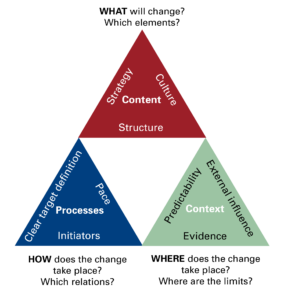Project management summarised for you in a nutshell – as an overview and with practical tips for orientation.
What is agile project management?
Agile project management is a modern method of project management that has evolved over the last decades. The agile approach differs from the classic approach in that it focuses on more flexibility and instead works in short iterations (also known as sprints) and is closely oriented to the needs of the project group. The goal of agile project management is to meet the needs of the customer and to adapt flexibly to constantly changing circumstances. Agile project management is based on the principle of self-organisation and teamwork. Tasks are not processed in linear order, but run through in cycles that are constantly repeated. The goal of agile project management is to make the end result as good as possible without fully implementing the plan. So the focus is on constantly testing and optimising ways of solving problems throughout the process. This allows the team to take more risks and react faster to changes in the environment.
Is there still a need for classical project management?
Classic project management is a traditional method of project management that has been around for many years and has proven to be a proven system. The classical approach is highly structured and usually involves several phases of planning, implementation and control. The planning phase includes the preparation of detailed plans for all aspects of the project and the timetable for implementation. After the planning phase is completed, the implementation phase begins, in which all the necessary steps must be carried out to achieve the project goal. In the control phase, it is checked whether the project goal has been achieved or not. The tasks are processed in sequential order and given fixed deadlines. Each step of the process is precisely documented and monitored. The goal of classic project management is to implement the plan as accurately as possible so that the end result is optimal.
And when should you choose agile project management?
Agile project management is always useful when the environment often changes quickly and innovation is rather unpredictable. Ideally, agile project management needs leaders who are very curious about different ways, methods and everything new. They are willing to take risks and are good at participating in open situations. If they are “on track”, they approach the topic with motivation, without brooding too long over indecisiveness. The Good Approach tool provides guidance on the appropriate approach.

Whether you choose classical or agile project management, it is important to understand the respective methodologies in order to run a successful project management. No matter which approach is chosen – it is important to focus not only on the technical aspects, but also to consider other factors:
- What about communication?
- How well does the team work together?
- How flexibly does one react to change requests?
Such questions help to run successful project management – whether with the classic or agile approach. Use the flow change navigator for orientation.
Read this (in german language) so-funktioniert-agile-change-management.
Frank Wippermann, supported by: https://app.neuro-flash.com/aiWriter
Graphic and image: Hurtig Design



